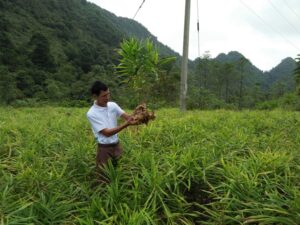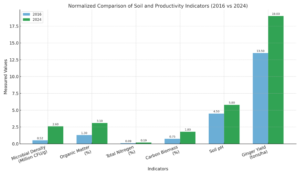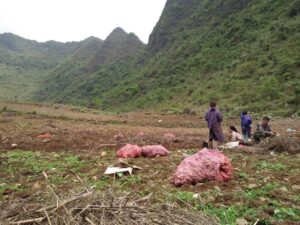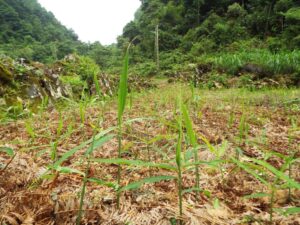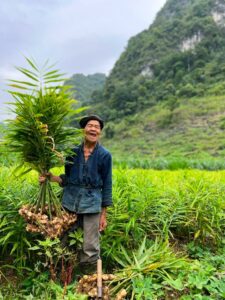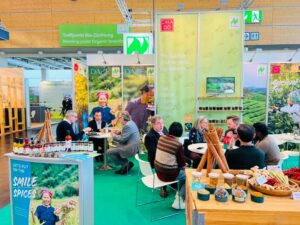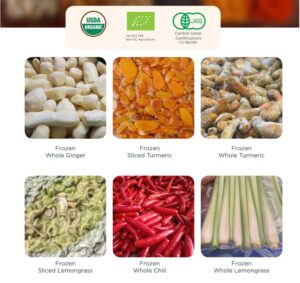1. Introduction
In the context of sustainable agriculture, applying crop rotation techniques and circular economy models has emerged as an effective solution to maintain soil fertility, control pests, and enhance farmers’ income. Previous studies (Lal, 2004; Petersen et al., 2015) have shown that rotating crops with legumes, cereals, and grasses not only supplements soil nutrients but also increases carbon biomass, improves soil structure, and promotes microbial biodiversity.
Since 2016, Dace has cooperated with farmers in Lục Khu to implement a ginger-turmeric rotation model with corn, soybean, peanut, and forage crops. This was combined with integrated livestock management to form a natural recycling loop: “Crop → Livestock → Organic Fertilizer → Crop”.
This study aims to evaluate the actual impacts after 8 years of application.
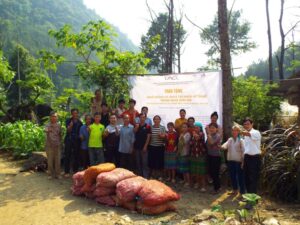
2. Methodology
– Location: Valley basins of Lục Khu, Hà Quảng, Cao Bằng. – Model:
– Rotation: Ginger/Turmeric → Corn/Soybean/Peanut/Grass → Ginger/Turmeric. – Organic fertilizer from composted manure (cattle, poultry).
– Annual organic farming training for farmers.
– Purchase prices 15–20% higher than market rates.
– Monitoring Parameters: – Soil microbial density.
– Organic matter content. – Total Nitrogen (N).
– Soil pH.
– Carbon biomass ratio. – Ginger yield.
– Scale (2024):
– 587 participating households.
– Expansion from 20 ha (2016) to 250 ha (2024).
– Certifications achieved: USDA Organic, JAS, KOC, Naturland, BioSuisse, Fair for Life.
3. Results
3.1. Soil Property Changes
| Indicator | 2016 | 2024 | Change (%) |
| Microbial density (Million CFU/g dry soil) | 0.52 | 2.6 | +400% |
| Organic matter (%) | 1.3% | 3.1% | +139% |
| Total Nitrogen (N%) | 0.09% | 0.19% | +111% |
| Carbon biomass (%) | 0.75% | 1.8% | +140% |
| Soil pH | 4.5 | 5.8 | +29% |
| Ginger yield (tons/ha) | 12–15 | 18–20 | +45–50% |
3.2. Illustration: Comparative Chart
4. Discussion
The rotation between ginger/turmeric and corn, soybean, peanut, and grasses resulted in:
– Increased carbon biomass: Cover crops and legumes provide organic matter and fix nitrogen, enhancing soil health.
– Soil pH stabilization: Reduced acidification, creating favorable conditions for ginger growth.
– Enhanced beneficial microbial populations: Improved organic matter decomposition and natural pest suppression.
– Yield improvement: Healthier soils led to significant increases in ginger productivity.
Circular Economy Model:
– Crops feed livestock.
– Livestock waste composted into organic fertilizer.
– Fertile soils benefit the next crop cycle.
5. Conclusion
After 8 years of implementing crop rotation combined with a circular economy model:
– Soil quality has significantly improved.
– Cultivation area and production volume expanded sustainably.
– Farmer incomes stabilized, with the region achieving prestigious international organic certifications.
– Currently, this is a sustainable model where farmers’ income from ginger and turmeric is 7–8 times higher than traditional corn and peanut cultivation.
– A sustainable ecosystem has been formed: healthier soils, rich microbial biodiversity, and crops that are more resilient to diseases, droughts, and flooding.
– Ginger and turmeric have become the dominant crops, helping farmers independently manage and plan their household economies.
– The strong linkage between farmers, enterprises, government supervision, and transparent customer engagement has reinforced the model’s sustainability.
By 2030, Dace plans to collaborate with farmers to build a “Green Province” in Cao Bằng, featuring over 10,000 farming households managing more than 3,000 hectares of diversified, environmentally friendly organic production, ensuring biodiversity conservation and meeting the growing demands of the global market.
References
– Lal, R. (2004). Soil Carbon Sequestration Impacts on Global Climate Change and Food Security.
– Petersen, B. M., et al. (2015). Effects of crop rotation on soil properties and productivity.
